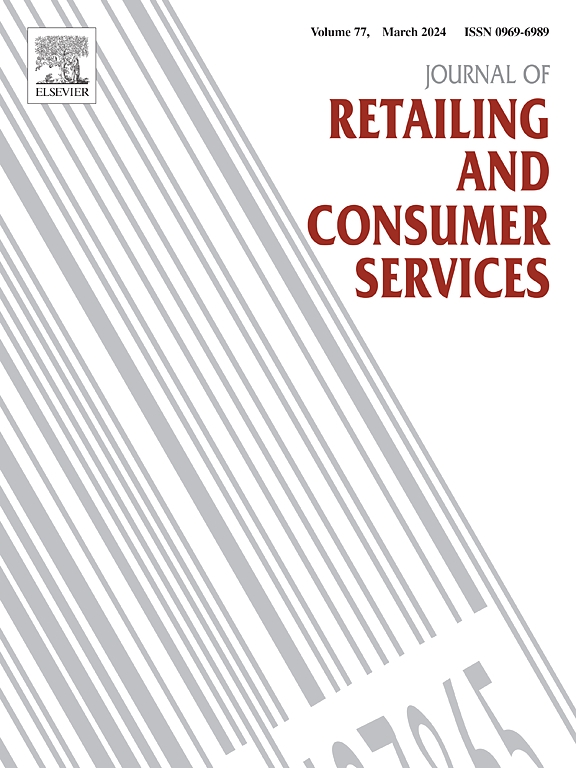制造商的渠道策略与消费者的失望厌恶和区块链防伪
IF 11
1区 管理学
Q1 BUSINESS
Journal of Retailing and Consumer Services
Pub Date : 2025-07-02
DOI:10.1016/j.jretconser.2025.104394
引用次数: 0
摘要
本研究调查了制造商原始直接渠道(OD渠道)暴露于假冒风险的场景。消费者遇到此类仿冒品会产生失望情绪,进而引发失望厌恶行为。支持区块链的零售渠道(BR渠道)可以消除假冒风险,但可能会引起消费者隐私问题。为了探讨制造商在消费者失望厌恶下引入BR渠道的策略,我们建立了一个博弈论模型。结果表明:(1)与人们的直觉相反,即使BR渠道没有假冒风险,制造商也不会总是引入它;即使OD渠道存在假冒风险,制造商也不一定要关闭它。(2)当消费者隐私关注度较高时,制造商不引入BR渠道;当隐私关注适度时,制造商采用无限制引入策略引入BR通道;当隐私关注较低时,如果消费者对OD通道的接受度较低(高),则制造商采用奇偶限制(引入替代)策略引入BR通道。(3)有趣的是,尽管失望厌恶降低了消费者对OD渠道产品的评价,从而提高了BR渠道的竞争力,但这种行为并不总是导致零售商的利润增加或制造商的损失。此外,包含区块链实现成本和消费者回报的两个扩展证实了核心发现的稳健性。本文章由计算机程序翻译,如有差异,请以英文原文为准。
Manufacturers’ channel strategy with consumer disappointment aversion and blockchain anti-counterfeiting
This study investigates a scenario in which a manufacturer’s original direct channel (OD channel) is exposed to counterfeiting risks. Consumers encountering such counterfeits experience disappointment, which subsequently triggers disappointment aversion behavior. The blockchain-enabled retail channel (BR channel) can eliminate counterfeiting risks but may raise consumer privacy concerns. To explore the manufacturer’s strategy of introducing a BR channel under consumer disappointment aversion, we develop a game-theoretic model. The results reveal that: (1) Counterintuitively, even though the BR channel is free of counterfeit risk, the manufacturer does not always introduce it; and even though the OD channel carries counterfeit risk, the manufacturer does not necessarily shut it down. (2) When consumer privacy concern is high, the manufacturer does not introduce the BR channel; when the privacy concern is moderate, the manufacturer adopts the unrestricted introduction strategy to introduce the BR channel; when the privacy concern is low, if consumer receptiveness of the OD channel is low (high), the manufacturer adopts the parity restriction (substitution introduction) strategy to introduce the BR channel. (3) Interestingly, although disappointment aversion reduces consumers’ valuation of products from the OD channel—thus enhancing the competitiveness of the BR channel—this behavior does not always lead to a profit gain for the retailer or a loss for the manufacturer. Furthermore, the two extensions incorporating blockchain implementation cost and consumer return confirm the robustness of the core findings.
求助全文
通过发布文献求助,成功后即可免费获取论文全文。
去求助
来源期刊
CiteScore
20.40
自引率
14.40%
发文量
340
审稿时长
20 days
期刊介绍:
The Journal of Retailing and Consumer Services is a prominent publication that serves as a platform for international and interdisciplinary research and discussions in the constantly evolving fields of retailing and services studies. With a specific emphasis on consumer behavior and policy and managerial decisions, the journal aims to foster contributions from academics encompassing diverse disciplines. The primary areas covered by the journal are:
Retailing and the sale of goods
The provision of consumer services, including transportation, tourism, and leisure.

 求助内容:
求助内容: 应助结果提醒方式:
应助结果提醒方式:


